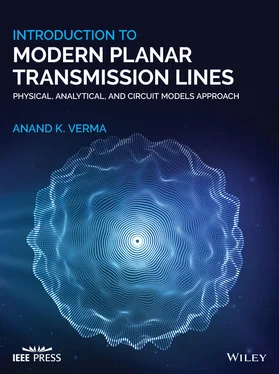Library of Congress Cataloging-in-Publication Data:
Names: Verma, Anand K., 1948– author.
Title: Introduction to modern planar transmission lines : physical, analytical, and circuit models approach / Anand K. Verma.
Description: Hoboken, New Jersey : Wiley‐IEEE Press, [2021] | Includes bibliographical references and index.
Identifiers: LCCN 2020050198 (print) | LCCN 2020050199 (ebook) | ISBN 9781119632276 (cloth) | ISBN 9781119632450 (adobe pdf) | ISBN 9781119632474 (epub)
Subjects: LCSH: Electric lines.
Classification: LCC TK3221 .V47 2021 (print) | LCC TK3221 (ebook) | DDC 621.3815–dc23
LC record available at https://lccn.loc.gov/2020050198LC ebook record available at https://lccn.loc.gov/2020050199
Cover Design: Wiley
Cover Image: © DamienGeso/Getty Images
To my loving and caring wife Kamini Verma and ever‐smiling grandchildren Naina, Tinu, and Nupur.
The planar transmission lines form the core of modern high‐frequency communication, computer, and other related technology. The subject has come up to the present level of maturity over the past three to four decades. The planar transmission lines are used not only as interconnects on the PCB board and IC chips; these are directly needed for the development of microwave and mm‐wave components in the form of microwave integrated circuits (MIC). The types of planar transmission lines, i.e. their physical structures and material medium, have been changing with the growth of technology in many other disciplines. Such efforts during recent years propelled the MIC to move in many exotic directions – MMIC, MEMS, LTCC, use of ferroelectrics, and high‐temperature superconductors, optically controlled microwave devices, nonlinear planar transmission lines, DGS, EBG, metamaterials, etc. The researchers with varying backgrounds have contributed much to research activities. Already the divergent planar technology has contributed significantly to the advancement of high‐frequency electronics and in the near future, more contribution will be made by it. The exotic planar transmission lines are not covered comprehensively in a single book. The present book is an attempt in this direction. The proposed book aims to provide a comprehensive discussion of planar transmission lines and their applications. It focuses on physical understanding, analytical approach, and circuit models for planar transmission lines and resonators in the complex environment .
The present book has evolved from the lecture notes, workshop, seminar presentation, and invited lectures delivered by the author at many universities and R&D centers. Some chapters were also initially written for the Ph.D. students to help them to understand the topics. Finally, it has evolved from notes prepared by the author as a scheme for the self‐study. The author started his academic career after 17 years of professional experience in the field of electrical engineering, broadcast transmitters, and satellite communication.
At present, the planar transmission lines are taught as part of the course on RF and microwave packaging, advanced electromagnetic field theory, and microwave design. It is also taught as an independent paper. However, a teacher has to consult divergent sources to prepare the lecture notes, as no single source at the teaching‐level is available. Moreover, the classroom teaching of the planar transmission lines is not as systematic as the classical metallic waveguide structures. It is due to the very nature of the subject itself. The available books are usually not classroom oriented. Usually, they can be grouped into two categories – 1. Design‐oriented books, 2. Monograph kind of books . Once we use the first category of books in the classroom, we end up writing only closed‐form expressions without any systematic derivation of the expressions. The systematic approach is important in the classroom environment. The second category of books is suitable for an experienced researcher or specialist. It is difficult to use them in the classroom. Thus, a teacher of this subject has to struggle between these two extremes to balance teaching throughout the semester. Finally, a teacher has to depend on personal experience and lecture notes.
There is a need to present, in one cover, the divergent topics of the planar transmission lines in a student‐friendly format. The researchers with varying backgrounds in physics, chemistry, engineering, and other fields have joined activities in the expanding area of the planar technology. The early researchers, R&D professionals in the industry, teachers, and students need a text that could be useful in faster acquisition of the physical modeling process and theoretical formulations used in the classical planar transmission lines. Similar treatment is also needed for the modern engineered EBG and metamaterial lines and surfaces.
Therefore, the real motivation for writing this intermediate‐level book is to fill the gap for a textbook on the planar transmission line that caters to the need for classroom teaching, early researchers with divergent backgrounds, and designers working in the microwave industry. The book is intended to help students both at the undergraduate and postgraduate levels. It also serves the purpose of a resource book for self‐study. The detailed derivations of results and physical modeling of the planar transmission lines are two basic concepts followed through the book . The present book is neither a design‐oriented book nor an advanced monograph. The book correlates the physical process with mathematical treatment. The advanced mathematical methods such as the conformal mapping method , variational method, and spectral domain method applied to planar lines are worked out in adequate details. The book further covers modern topics such as the DGS/EBG, metamaterial‐based planar transmission lines, and surfaces . The approach used in writing the book is perhaps less formal than most available texts. This approach is helpful for classroom teaching. It also assists the reader to follow the contemporary developments in planar technology.
The author is thankful to Prof. Karu P. Esselle and Prof. Graham Town, School of Engineering, Macquarie University, Sydney, for supporting Adjunct Professorship at Macquarie University. The author is also thankful to Prof. Enakshi K. Sharma, Department of Electronic Science, South Campus, Delhi University, for continuous discussions on topics related to EM‐Theory, Wave propagation, etc. The author sincerely appreciates the help and guidance provided by Prof. Kai Chang, Department of Electrical Engineering, Texas A&M University during the review process of the book. The author also appreciates the active interest taken by Mr. Brett Kurzman and his team of Wiley Publishing for the review and friendly administrative support.
The author is particularly grateful to Dr. I.J. Bahl, Editor‐in‐Chief, Int. J. of RF & Microwave Computer‐Aided Engineering, John Wiley, USA ; Prof. Zhongxiang Shen, School of Electrical and Electronic Engineering, Nanyang Technological University, Singapore ; and Prof. Ladislau Matekovits, Department of Electronics and Telecommunications, Politecnico di Torino, Italy, for reading book chapters and providing valuable suggestions to improve the book.
The author has benefitted from the comments, suggestions, and corrections of many colleagues, teachers, and students. The author would like to thank the following people for their useful contributions toward corrections and useful discussions: Dr. Koteshwar Rao, Dr. Harsupreet Kaur, Dr. Kamlesh Patel, Mr. Amit Birwal, Dr. Ashwani Kumar, Dr. Paramjeet Singh, Dr. Y.K. Awasthi, and Mr. Prashant Chaudhary from the Department of Electronic Science, Delhi University ; Dr. Raheel Hashmi, Dr. Sudipta Chakraborty, and Dr. Rajas Prakash Khokle of School of Engineering, Macquarie University, Sydney ; Dr. Nasimuddin of Institute for Infocomm Research, Singapore ; Prof. Asoke De, Dr. Priyanka Jain, Ms. Priyanka Garg of Department of Electrical Engineering, DTU, Delhi ; Mr. Shailendra Singh of Product Development and Innovation Center, Bharat Electronics Ltd., Bengaluru, India ; Dr. Rajesh Singh, Microwave Radiation Laboratory, University of Pisa, Italy ; Dr. Archna Rajput, IIT Jammu, India; Dr. Ravi Kumar Arya, Dept. of ECE, NIT, Delhi . The author is especially thankful to his students, Mr. Shailendra Singh and Mr. Prashant Chaudhary for their continuous help in correction of all chapters.
Читать дальше












